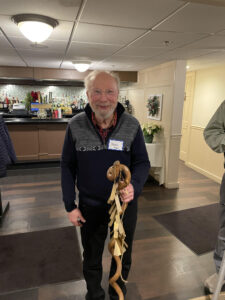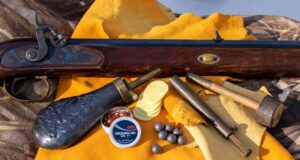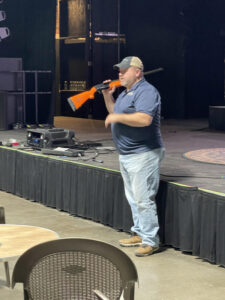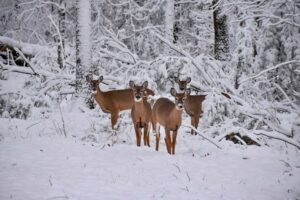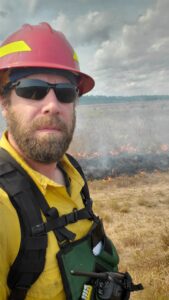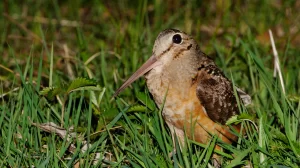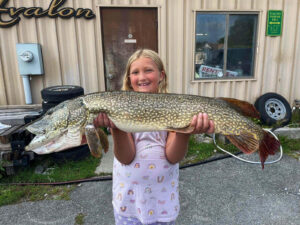At its December7, 2023 Holiday Party, the Taconic Chapter of Trout Unlimited (TU) presented to retired doctor Charles Wohl of Lenox its most prestigious award, the Crooked Staff Award. He has been a member of TU for some 40 years or so. He originally started out as a member of the Konkapot Chapter of TU in southern Berkshire County until it merged with the Taconic Chapter in the 1980s.
In the past Charles has made numerous excellent presentations at the Chapter meetings about rivers that he has fished. He is an excellent fly tier and has conducted fly tying demonstrations over the years in places such as the Berkshire National Fish Hatchery. In May of 1983 some of his flies were on display at the Berkshire Museum when it held its exhibit “Fly Tying, Fly Fishing: the gentle sport” which ran from April 6 to May 13, 1984.
Over the years, Charles has written fishing articles for The Backcast, the official newsletter of Taconic TU, for the now defunct literary journal The Berkshire Review, and for this Berkshire Eagle column. I foresee another one of his articles appearing in this column in the future.
He gave fly tying lessons for a couple of years at the late Fred Moran’s shop Points North in Adams. For fundraisers, various organizations auctioned off fly casting lessons from him and then a day of guided fly fishing on the Housatonic River in Connecticut with a gourmet lunch prepared by his wife Alba. He also participated in teaching fly casting at Casting for Recovery events. (The Mission of Casting for Recovery is to enhance the lives of survivors and thrivers of breast cancer by connecting them to each other and nature through the therapeutic sport of fly fishing and providing oncology medical and psychosocial support at no cost). Over the decades he has also donated generously to TU’s fundraisers.
Charles was totally caught off guard, and upon receiving the award was only able to say a few words, mostly about his surprise and his feeling that it was undeserved but much appreciated. Sorry Charles, but everyone in that room felt that you greatly deserved the award.
“I think for me” said Charles, “membership in TU and getting out on the rivers has given me the opportunity to meet so many really nice men and women who are great fishermen and fisherwomen, but, more importantly, dedicated to efforts to preserve cold water environments. My involvement with TU and fly fishing has, in general, shown me that trout live in very pretty places, including some areas of Europe.”
After opening remarks by Chapter President Justin Adkins of Williamstown, the presentation was emceed by Taconic TU Director Marc Hoechstetter of West Cummington. Mr. Goodrod’s staff and flyrod were presented to Charles by the previous recipient Fran Marzotto of Pittsfield.
You may ask, what is the Crooked Staff Award and how did it come to be?
The history of the Crooked Staff has already been featured in this column over the years a couple of times. With your indulgence, lets one more time refresh our memories of how this award came about and the story behind this rich Taconic TU tradition.
The staff itself was the brainchild of Ken Welch, one of the chapter’s past members who has since moved to the New York State Finger Lakes area and then later to Florida. He related the following story about the origin of the staff which he claimed to be true. However, members wonder if the social hour preceding the meeting when he introduced it affected his veracity. In any event the moral of the story is still solid:
“Many years ago, there lived a trout fisherman who was the epitome of the ultimate gentleman angler. He was a man who was honest to a fault, one who needed no guidelines such as game laws by which to live. He was a man who always did the proper thing because it was the right thing to do. Mr. Ernest Goodrod was that man.
He would never wade into another man’s pool, he never kept under-sized fish, nor exceeded the lawful limit. In fact, he felt those laws weren’t written for him since he had always practiced “Catch and Release”. Mr. Goodrod stopped to help young anglers that he felt could use his expertise; he never lied about the quantity or the quality of his catches. He was free with his advice and shared the location of favorite fishing holes with strangers. He was truly a gentleman’s gentleman.
In spite of having a heart condition, he fished frequently, and often alone. Being of an advanced age he always had his wading staff tied to his belt with a rawhide tether. It was cut from a strong, straight tree and left in its natural state. Straight, strong, and pure, not unlike Mr. Goodrod.
But alas, the day came when he didn’t return from his favorite stream; his heart had finally failed him. He was found at the Bridge Pool by the local near-do-well, a despicable man who lied cheated and connived his way through life. He was noted for following the trout stocking trucks to take as many trout as possible. When this awful man found Mr. Goodrod, he stripped him of his rod, vest, waders and wading staff. For most of that summer he used his stuff, including the staff, but every time he broke the law the staff would get shorter due to it taking on a coil, and eventually the staff became unusable.
One evening the local game warden arrested the bum, jailed him, and confiscated all his fishing tackle, including the crooked staff. Everyone knew that the staff was once the property of Mr. Goodrod and the story spread that if a real gentleman of Mr. Goodrod’s caliber were to handle the staff it would straighten out to its original splendor.
Ken Welch obtained the staff, but in spite of being a fine gentleman the staff remained crooked. Somewhere Ken had a hidden flaw. He was aware of the fine character of the members at the Taconic Chapter of TU and figured one of its members could remove the coils. Ken suggested that if the staff was presented to the one who most represented the ideals of TU, the staff would be restored, but alas after many, many recipients, it remains crooked. Apparently, each honoree had a hidden flaw in his or her character. Someday the likes of Mr. Goodrod will be found, so it is hoped.”
Well, nearly every year since the mid 1980’s the Chapter’s Board of Directors selected one of its members to receive this coveted award. The person is selected as the member who best represents the ideals of T.U. (conserving, protecting, and restoring North America’s cold- water fisheries and their watersheds). This member holds the Crooked Staff for the following year until it is either passed on to another deserving member or is held, if none is deemed deserving.
There have been 31 previous Crooked Staff recipients over the years. Chronologically, they were as follows: Francis F. Conroy, Ernest Long, Jerry Zink, Ted Giddings, Gene Chague, Ken Welch, Paul and Homer Ouellette, John Kastrinakis, Cy Henry, Michael Shepard, Clem Ferris, Tony Lorio, Dick Bordeau, Paul Knauth, Fred and Marilyn Moran, Herb Rod, Dave Oclair, Karen Karlberg, Marc Hoechstetter, Len Gigliotti, Ron Wojcik, Charles Lahey, Allen Gray, Doug and Gail Yates, John Burns, Bill Travis, Henry Sweren, Fran Marzotto and now Charles Wohl.
In 2016, Taconic TU charter member Homer Ouellette, of Pittsfield, himself a Crooked Staff recipient, passed beyond the riverbend. Unbeknownst to the TU members, he had purportedly gained possession of Mr. Goodrod’s flyrod. Homer’s brother, the late Paul Ouellette of Lanesboro, brought it to a TU meeting hoping that it would be presented to future deserving crooked staff recipients. On it is inscribed, “Property of Mr. Ernest Goodrod.” Hence, a new Taconic TU tradition had been formed.

